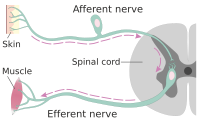
Photo from wikipedia
In recent years, balloon enteroscopyassisted endoscopic retrograde cholangiopancreatography (BA-ERCP) has been performed for biliary pancreatic endoscopic procedures for postoperative reconstruction of the intestinal tract. In BA-ERCP, especially in cases after… Click to show full abstract
In recent years, balloon enteroscopyassisted endoscopic retrograde cholangiopancreatography (BA-ERCP) has been performed for biliary pancreatic endoscopic procedures for postoperative reconstruction of the intestinal tract. In BA-ERCP, especially in cases after Rouxen-Y anastomosis, it is often difficult to identify the afferent limb. Several methods have been reported so far [1–3]. Herein we report a new method that can discriminate more objectively. We present a video of a typical case (▶Video 1). The patient was an 83-yearold man who had undergone total gastrectomy and Roux-en-Y anastomosis for gastric cancer (▶Fig. 1). Because of treatment for obstructive jaundice, he was transferred to our hospital and underwent BA-ERCP. The initial procedure, which took 2 hours, could not be completed as it was difficult to identify the afferent limb. BA-ERCP was attempted 4 days later. After crossing the anastomotic site (▶Fig. 2), a mixture of gel (VISCOCLEAR; Otsuka Pharmaceutical Factory, Tokushima, Japan) mixed with contrast medium was slowly sprayed. Outflow of mixed fluid reflecting forward peristalsis was confirmed, and it was judged to be an efferent limb (▶Fig. 3). Next, the endoscope was advanced into the other lumen and the mixed solution was sprayed in the same manner. Retention of the mixed solution reflecting reverse peristalsis was confirmed, therefore this lumen was considered an afferent limb (▶Fig. 4). After this, we were able to reach the duodenal papilla and complete endoscopic bile duct drainage (▶Fig. 5). It took 35 minutes to reach the duodenal papilla. The use of gel in gastrointestinal endoscopy has been reported as a means to secure the visual field for endoscopic hemostasis (gel immersion method [4]). The identification of the afferent limb in the postoperative reconstructed bowel that we reported is a new method of using gel. This simple and inexpensive method is thought to greatly contribute to finding the papilla during BA-ERCP in Video 1 A case in which “retention of gel mixed with contrast medium under fluoroscopy” was useful as a new method to determine the afferent limb in balloon enteroscopyassisted endoscopic retrograde cholangiopancreatography. ▶ Fig. 1 Computed tomography on admission showed bile duct dilatation and reconstructed bowel after gastric surgery.
Journal Title: Endoscopy
Year Published: 2022
Link to full text (if available)
Share on Social Media: Sign Up to like & get
recommendations!